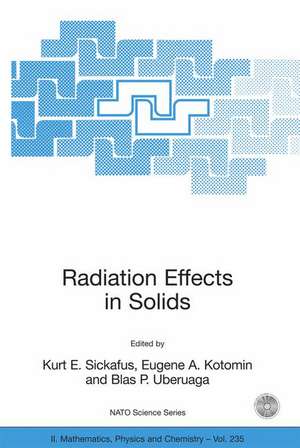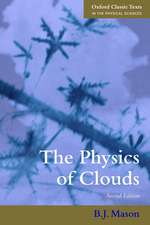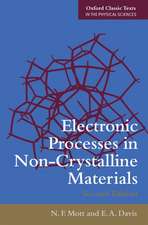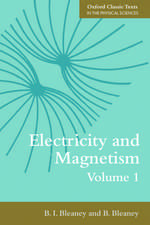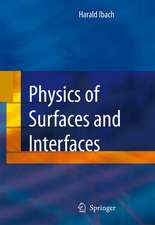Radiation Effects in Solids: NATO Science Series II: Mathematics, Physics and Chemistry, cartea 235
Editat de Kurt E. Sickafus, Eugene A. Kotomin, Blas P. Uberuagaen Limba Engleză Mixed media product – 23 feb 2007
Din seria NATO Science Series II: Mathematics, Physics and Chemistry
- 18%
 Preț: 1272.32 lei
Preț: 1272.32 lei - 15%
 Preț: 644.30 lei
Preț: 644.30 lei - 18%
 Preț: 1848.33 lei
Preț: 1848.33 lei - 18%
 Preț: 1235.76 lei
Preț: 1235.76 lei - 15%
 Preț: 649.87 lei
Preț: 649.87 lei - 18%
 Preț: 957.75 lei
Preț: 957.75 lei - 15%
 Preț: 656.58 lei
Preț: 656.58 lei - 18%
 Preț: 1235.43 lei
Preț: 1235.43 lei - 18%
 Preț: 960.13 lei
Preț: 960.13 lei - 18%
 Preț: 1225.79 lei
Preț: 1225.79 lei - 15%
 Preț: 666.41 lei
Preț: 666.41 lei - 18%
 Preț: 1835.07 lei
Preț: 1835.07 lei - 15%
 Preț: 640.71 lei
Preț: 640.71 lei - 18%
 Preț: 954.45 lei
Preț: 954.45 lei - 18%
 Preț: 1227.36 lei
Preț: 1227.36 lei - 15%
 Preț: 646.11 lei
Preț: 646.11 lei - 18%
 Preț: 948.61 lei
Preț: 948.61 lei -
 Preț: 400.10 lei
Preț: 400.10 lei - 18%
 Preț: 959.82 lei
Preț: 959.82 lei - 18%
 Preț: 944.19 lei
Preț: 944.19 lei - 18%
 Preț: 1838.38 lei
Preț: 1838.38 lei - 18%
 Preț: 1222.49 lei
Preț: 1222.49 lei - 18%
 Preț: 939.94 lei
Preț: 939.94 lei - 18%
 Preț: 950.66 lei
Preț: 950.66 lei - 18%
 Preț: 957.44 lei
Preț: 957.44 lei - 15%
 Preț: 656.74 lei
Preț: 656.74 lei
Preț: 655.45 lei
Preț vechi: 771.12 lei
-15% Nou
Puncte Express: 983
Preț estimativ în valută:
125.42€ • 134.12$ • 104.57£
125.42€ • 134.12$ • 104.57£
Carte tipărită la comandă
Livrare economică 18 aprilie-02 mai
Preluare comenzi: 021 569.72.76
Specificații
ISBN-13: 9781402052941
ISBN-10: 1402052944
Pagini: 604
Ilustrații: IX, 592 p. With CD-ROM.
Dimensiuni: 155 x 235 x 32 mm
Greutate: 0.84 kg
Ediția:2007
Editura: SPRINGER NETHERLANDS
Colecția Springer
Seria NATO Science Series II: Mathematics, Physics and Chemistry
Locul publicării:Dordrecht, Netherlands
ISBN-10: 1402052944
Pagini: 604
Ilustrații: IX, 592 p. With CD-ROM.
Dimensiuni: 155 x 235 x 32 mm
Greutate: 0.84 kg
Ediția:2007
Editura: SPRINGER NETHERLANDS
Colecția Springer
Seria NATO Science Series II: Mathematics, Physics and Chemistry
Locul publicării:Dordrecht, Netherlands
Public țintă
ResearchCuprins
TO THE KINETIC MONTE CARLO METHOD.- ACCELERATED MOLECULAR DYNAMICS METHODS.- RADIATION INDUCED STRUCTURAL CHANGES THROUGH IN-SITU TEM OBSERVATIONS.- RADIATION DAMAGE FROM DIFFERENT PARTICLE TYPES.- HIGH DOSE RADIATION EFFECTS IN STEELS.- RADIATION-ENHANCED DIFFUSION AND RADIATION-INDUCED SEGREGATION.- THE KINETICS OF RADIATION-INDUCED POINT DEFECT AGGREGATION AND METALLIC COLLOID FORMATION IN IONIC SOLIDS.- MICROSTRUCTURAL EVOLUTION OF IRRADIATED CERAMICS.- OPTICAL & SCINTILLATION PROPERTIES OF NONMETALS: INORGANIC SCINTILLATORS FOR RADIATION DETECTORS.- RADIATION-INDUCED PHASE TRANSITIONS.- TO MATHEMATICAL MODELS FOR IRRADIATION-INDUCED PHASE TRANSFORMATIONS.- AMORPHOUS SYSTEMS AND AMORPHIZATION.- ION BEAM MIXING.- RADIATION EFFECTS IN NUCLEAR FUELS.- ROLE OF IRRADIATION IN STRESS CORROSION CRACKING.- ION BEAM SYNTHESIS AND TAILORING OF NANOSTRUCTURES.- RESIDUAL STRESS EVOLUTION DURING ENERGETIC PARTICLE BOMBARDMENT OF THIN FILMS.- PEROVSKITE-BASED COLOSSAL MAGNETORESISTANCE MATERIALS AND THEIR IRRADIATION STUDIES: A REVIEW.- EXPOSURE OF BONE TO IONIZING RADIATION.
Caracteristici
Contains first-ever reviews of special topics: Kinetic Monte Carlo (KMC) simulation of radiation damage Accelerated molecular dynamics (AMD) simulations of radiation damage Ion irradiation induced residual stress effects Mathematical models for irradiation-induced phase transformations Radiation damage from different particle types
